
East Grinstead High Level Station: Gallery 5: 1962 - 1964 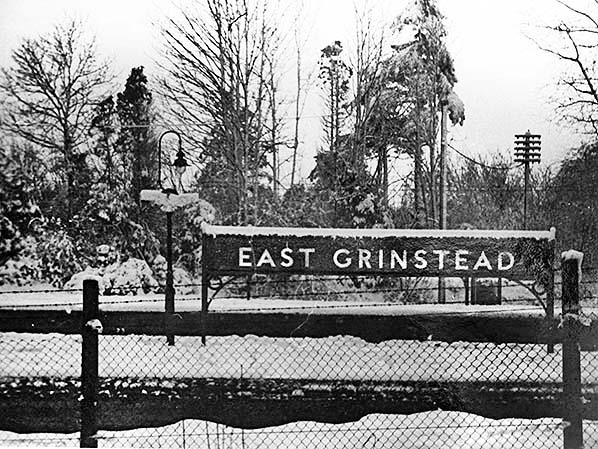
One of two wintry scenes, both probably captured the same day during the winter of 1962/3. The Southern 'target' sign is almost completely covered, suggesting the snow was accompanied by strong winds, yet the face of the running-in board is clear. Perhaps staff had ensured the name was visible. The location is the west end of the station and facing south.
Photo by Alan & Lynne Cullen 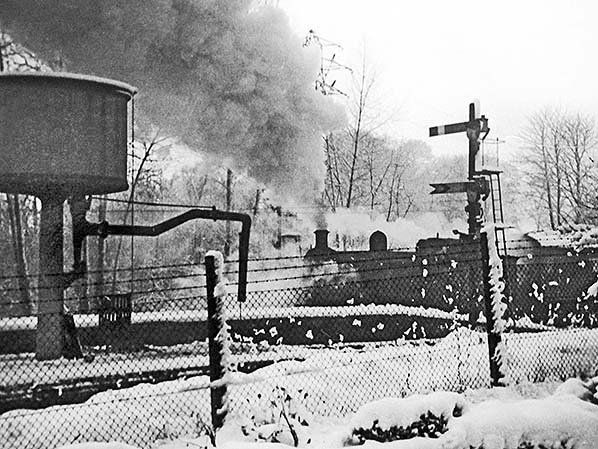 The second of the two wintry scenes probably captured on the same day during with winter of 1962/3. Here an unidentified H Class 0-4-4T shuffles away from Platform 3 with a Push-Pull train for Three Bridges. The brazier by the water tower is not in use as might be expected, but the habit was to fire them up during the hours of darkness when temperatures dropped to freezing or below, or no locomotives were taking on water. At other times the flow of water, via underground pipes, would prevent tanks, water cranes and columns from freezing.
Photo by Alan & Lynne Cullen 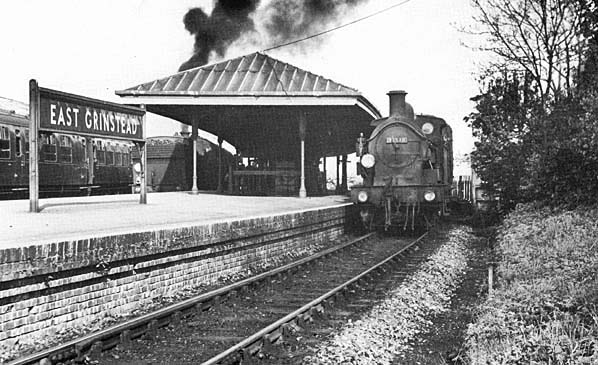 In May 1963 Class H 0-4-4T No. 31518, right, awaits departure for Three Bridges. At the opposite platform face the fire has just been stoked of what appears to be a Class M7 0-4-4T. It carries the disc headcode for Three Bridges - Tunbridge Wells but also has a tail lamp affixed to the bunker, suggesting it is coupled to a Push-Pull set the wrong way round to the conventional practice. At far left stands main line stock, probably one of the sets used on Victoria or London Bridge services.
Photo by J Gammell 
A view from a house at the end of Grosvenor Road and quite obviously during the summer. The train is standing at Platform 6 and has arrived from the Oxted direction. At its head is what appears to be a BR Standard 2-6-4T. The third vehicle is a brake-end, suggesting the two vehicles between it and the locomotive had been added to strengthen, in terms of accommodation, the train. There would have been another brake-end vehicle at the rear of the train.
Photo by Alan & Lynne Cullen 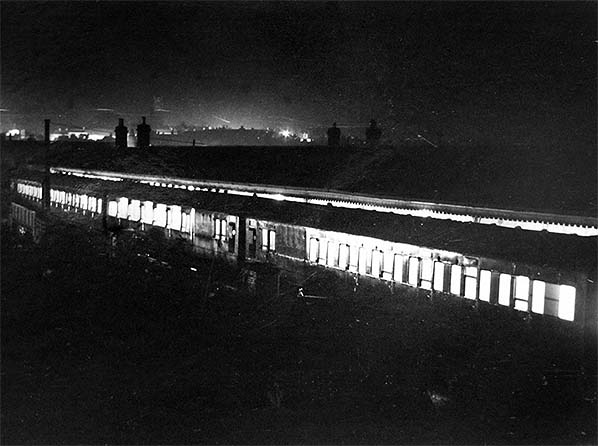 A similar view to the photo above but obviously taken during the hours of darkness. This time the train comprises a 3-set behind the locomotive and what was likely another 3-set at the rear. In both views London Road bridge can be seen left of centre.
Photo by Alan & Lynne Cullen 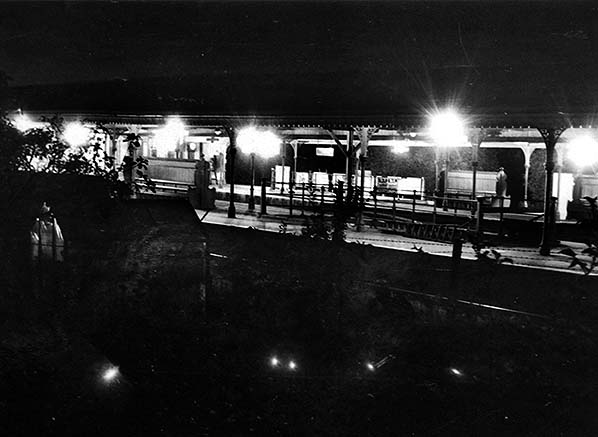
An atmospheric night-time scene from the 1960s viewed from the rear of a house on Grosvenor Road. The camera was facing south south-east and Platform 6 is nearest. The station was illuminated entirely by gas and while this was far superior to oil lighting, the apparent brilliance will be down to the longer exposure time required during the hours of darkness.
Photo by Alan & Lynne Cullen  On 22 March 1964 'The Sussex Downsman' railtour waits at East Grinstead with Bulleid Q1 Class 0-6-0 No. 33027. The tour was from Waterloo to Victoria and covered many routes which are now closed. Several locomotives were used, with the Q1 working the Waterloo - Horsham and Three Bridges - Tunbridge Wells West sections. The Q1 Class was O. V. S. Bulleid's wartime austerity design, using the absolute minimum of materials and with features considered unnecessary, such as splashers, absent. Nevertheless it will be noticed efforts were made to match the profile of the tenders to that of Bulleid's coaching stock. The class was primarily intended for goods working but use on passenger trains, specials aside, was not unknown. Reputedly the most powerful 0-6-0 steam locomotive ever to operate in Britain, of the forty examples built one has survived into preservation. In the background of this view East Grinstead 'B' signal box, formerly East Grinstead East can be seen. With a Saxby & Farmer 43-lever frame it was the busier of High Levels two signal boxes.
Photo by Bevan Price 
On 22 March 1964 'The Sussex Downsman' railtour pauses at Platform 4 on its way from Three Bridges to Tunbridge Wells West. The locomotive, out of view, was Bulleid Class Q1 No. 33027 and a photograph of this locomotive is seen above. The tour was a joint RCTS/LCGB event. At Tunbridge Wells West the Q1 would be detached and unrebuilt Bulleid Pacific No. 34066 'Spitfire' would be attached to the other end of the train, which would then proceed to Lewes and Brighton via Heathfield with another locomotive change at Pevensey. The coaching stock was 9-set No. 237. Southern coaching stock sets not infrequently were reformed, lengthened or shortened as requirements demanded. No. 237 had began life as a Maunsell 4-set but in 9-set from as seen here it was a mix of Bulleid and BR Mk 1 stock. The vehicles carried roofboards proclaiming 'THE SUSSEX DOWNSMAN RAIL TOUR'. One interesting carriage is present midway along the train and recognisable by its deeper side panels. It is a Bulleid catering vehicle and one of those rebuilt from a 'Tavern Car', another of Oliver Bulleid's strange, or perhaps to be more polite 'novel', ideas which he inflicted upon the travelling public. Later in this tour the train would visit the Kemp Town branch, behind yet another locomotive and this time an Ivatt 2-6-2T, but with set No. 237 temporarily reduced to seven vehicles. Note the brazier beside the water tower. These were lit during winter to prevent water columns and towers of the 'parachute' type seen here from freezing. To this end the braziers were usually, but not always, successful and much depended upon how often locomotives stopped to take on water. Photo from John Mann collection 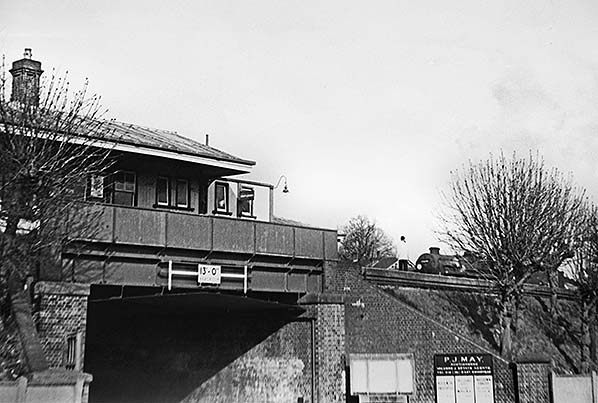 Station Road bridge with its 13' 0" headroom seen from Station Approach. A BR Standard Class 4 4-6-0 with double chimney is present but its number in unclear, other than 7507? P. J. May were auctioneers, valuers and estate agents. The rest of the details are unreadable but their telephone number, which was East Grinstead 315, appears to be given in the obsolete format with number preceding exchange name. Up on the platform the Gentlemen's lavatory looks to be a more modern extension to the original building although the narrow windows are identical.
Photo by Alan & Lynne Cullen 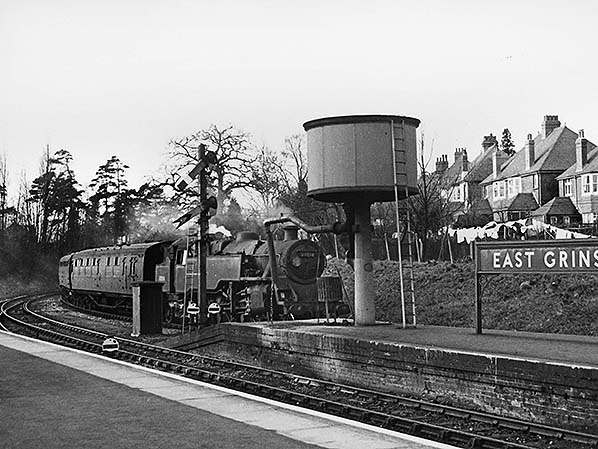
BR Standard 2-6-4T No. 80016 arrives at Platform 6 with a train from the Oxted direction. The houses on the right are at the southern end of Crescent Road, close to its junction with Grosvenor Road. One wonders if the photograph was taken on a Monday for at one time this was the traditional washing day. People hung their washing out to dry regardless of smuts from steam locomotives and other sources. However, anybody who lit a bonfire when a neighbour had washing hanging out to dry did so at their peril
Photo by Alan & Lynne Cullen 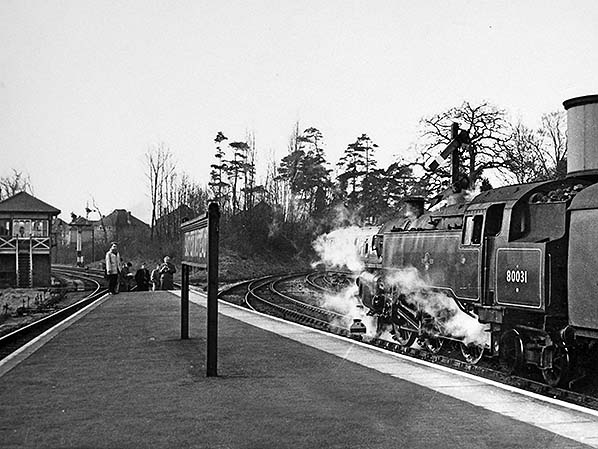
Sometime between September 1958 and September 1964 a BR Standard 2-6-4T departs from Platform 5 bound for Oxted and presumably either London Bridge or Victoria. Another train, also seen in the picture above, is arriving from the same direction at Platform 6. The group of enthusiasts may suggest a railtour was present but no record has been found of No. 80031 on such a duty at East Grinstead. Perhaps it was 22 March 1964 and the enthusiasts were awaiting the arrival of 'The Sussex Downsman', seen and described two picures above. Withdrawn on 20 September 1964, No. 80031 was one of just two BR steam locomotives to be sold for scrap to the Steel Supply Company of West Drayton, the other being No. 80148 which had been withdrawn three months prior to No. 80031'. Photo by Alan & Lynne Cullen 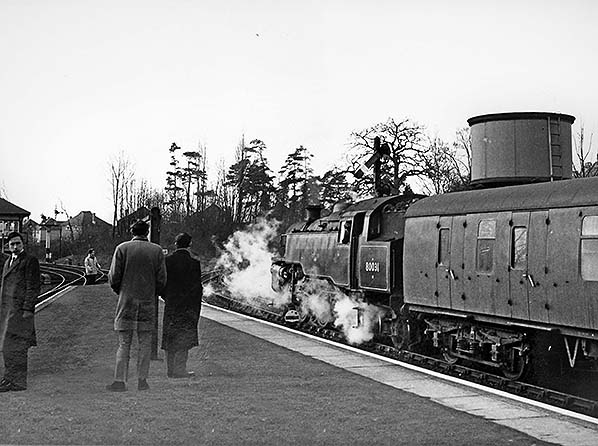 Another view taken at the same time as the photo above.
Photo by Alan & Lynne Cullen  A final view taken on the same day as the pictures above. This time a Class H 0-4-4T departs Platform 3 with a Maunsell Push-Pull set for Three Bridges. The signal partially hidden by the locomotive was installed in 1958, having replaced an older signal at the end of the platform. A final view taken on the same day as the pictures above. This time a Class H 0-4-4T departs Platform 3 with a Maunsell Push-Pull set for Three Bridges. The signal partially hidden by the locomotive was installed in 1958, having replaced an older signal at the end of the platform.Photo by Alan & Lynne Cullen
|


 Home Page
Home Page